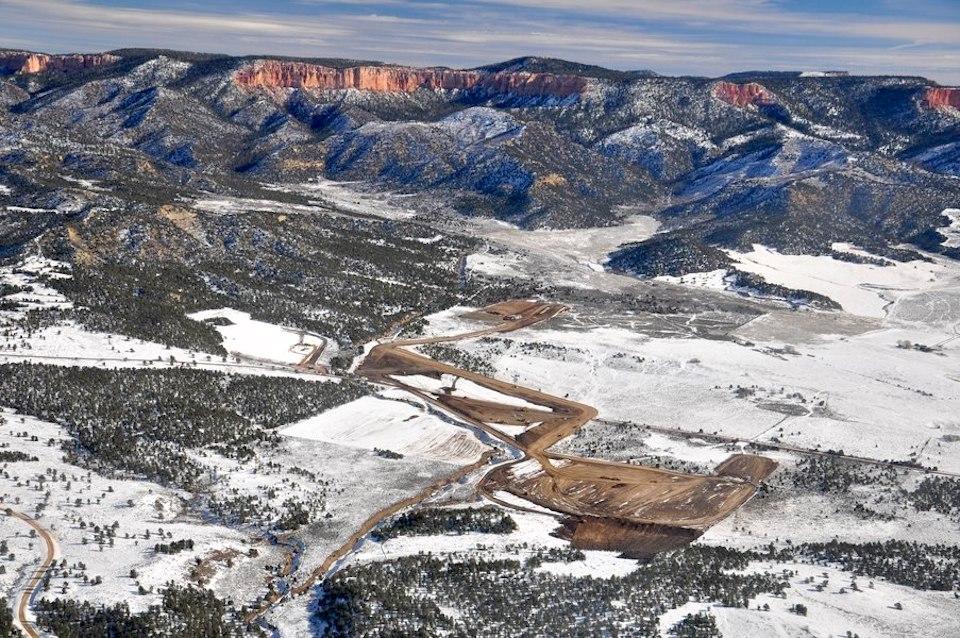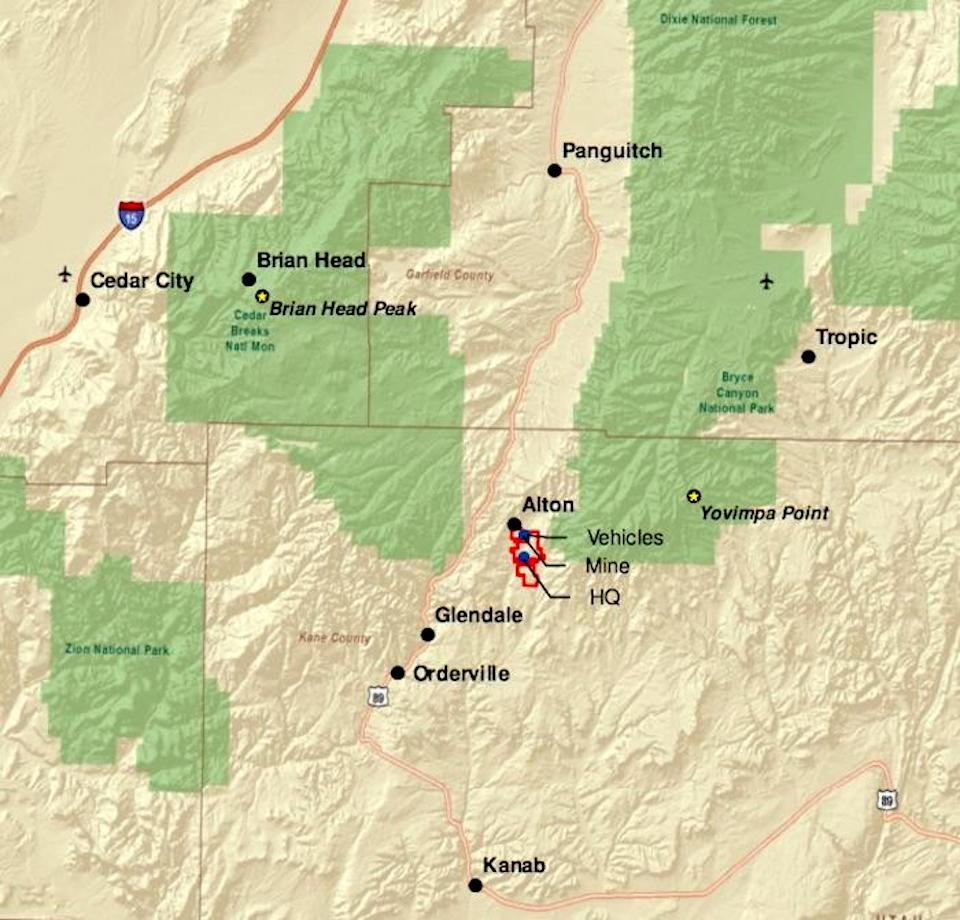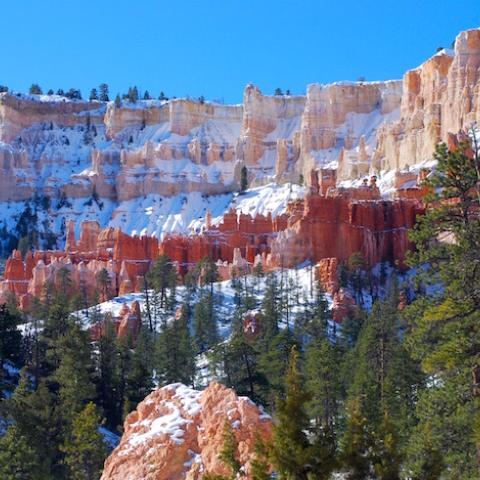
Aerial view of Alton Coal's Coal Hollow Mine site/Southern Utah Wilderness Alliance
The Interior Department has approved the expansion of a coal mine about ten miles from Bryce Canyon National Park in Utah. While the department said approval of the Alton Coal expansion "will further the Administration’s energy dominance and economic prosperity goals," demand for coal has been on a downward slide.
“American coal jobs matter,” Acting U.S. Secretary of the Interior David Bernhardt said late last week. “Coal production on federal lands provides nearly 40 percent of our nation’s coal. By approving these projects today, we will ensure that these mines are operational for years to come, providing well-paying jobs and affordable energy to the people of Utah.”
Park advocates, however, say the administration's move reflects a "war on national parks and public lands."
"Alton Coal Tract poses direct threats to the landscapes, air and pristine night skies at nearby Bryce Canyon National Park, a revenue-generating engine for the region, supporting thousands of jobs and welcoming 2.6 million visitors each year," said Cory MacNulty, the National Parks Conservation Association's associate director in its Southwest Region. "Today’s announcement by the Interior Department foreshadows the attacks on our parks and public lands to come, under proposed Interior Secretary David Bernhardt.”
The Coal Hollow Mine developed by Alton Coal went into production in 2010. Just a year later, the company sought permission to expand its operation to more than 3,500 acres. How expansion, if it occurs, impacts the region's tourism industry remains to be seen.

Coal Hollow Mine locator map/BLM
Alton Coal has proposed running coal trucks 10 minutes apart 24 hours a day, six days a week from the mine. Their route would take them 30 miles north on U.S. 89 to Panguitch, and then west on State Route 20 to Interstate 15, and then south to a location near Cedar City where the company envisions a railhead to send the coal to the West Coast.
Both 89 and 20 are winding, rolling, two-lane routes that pass through broken forests of pine, juniper and aspen as they connect Zion National Park, Bryce Canyon National Park, and Cedar Breaks National Monument. During summer those roads are full of tourist traffic that includes a good number of ponderous recreational vehicles. In Panguitch, which funnels south-bound traffic to Bryce Canyon, U.S. 89 goes through the middle of town and requires a 90-degree turn for both north-bound and south-bound traffic.
In studying the expansion, BLM staff noted there were issues with it. Business owners in Panguitch have voiced concerns at such an increase in coal truck traffic, the agency's Final Environmental Impact Statement noted. In the past, Dixie National Forest staff expressed concerns how the mine could impact air and water quality in the forest and impact scenic visitas and wildlife habitat.
Latest economic figures show the tourism industry greatly dwarfs the coal industry in Utah, generating $9.1 billion in overall traveler spending vs. $600 million in coal production.



 Support Essential Coverage of Essential Places
Support Essential Coverage of Essential Places







Comments
Sounds like fear mongering. The mine is on the opposite side of the park that 99% of the people visting Bryce canyon even see. What about the town of Tropic which is in direct view of most of the view points at the park? The light pollution there? Should we move the town?
It says this coal will be shipped to the west coast via rail. Is this being shipped overseas?
Light pollution? Tropic, with a population of around 800? Come on you can do better than that in support of 19th and 20th century energy technology.
So about 45,000 trucks per year, compared to 4.5 million annual visitors to the park. And they are going to argue which one is bad for the environment?
I certainly don't relish increased noise or the sound of trucks rumbling down the road either but I'd really have a difficult time using this argument.
Coal is old technology. The revenue coal provides is nothing compared to what will be lost in tourit dollars People want areas that are unspoiled by mining. Trucks every 10 minutes 24 hours a day that is ridiculous
Have you driven those roads? We spent an idyllic week there in september. I can imagine what it would have been like with a humongous coal truck barreling down on me each time I turned off to Gawk and every 10 minutes no less. I would never go back and I would tell everyone the same. Until we find a way to use the coal intelligently and locally, leave the coal in the ground. Save it for later, when I'm sure we'll find a much better use for 2-300 million year old stuff than to burn it.
berbransan - it might be "old" but it still supplies 30% of our electricity and only recently was surpassed by natural gas which many want to eliminate as well. We have a long way to go before these two can efficiently be replaced by other sources. The number of trucks does seem to be somewhat of a concern - not so much to the Park but to the traffic and residents along that road. It does say this is an expansion of activity. I am curious what the current level of trucking is.
Of course, primarily to China. Australia is in the process of ramping up it's production also for the chinese market. And China, they're racing ahead to reduce their coal consumption. So we'll have a glut on the market with the concomittant falling prices, the mines will shutter in bankruptcy, the locals will be faced with no work, no money and saddled with a home area destroyed by trucks and dust..... with no one to pick up and clean up. Just ask the people in the recent boom and bust in the Dakota oil shale patch. If the mine wants to ship all that it can then they should have to fund upfront enough money to fix it all when they inevitably close down 10 years from now. Why should "We" pick up the tab. The actual people who are in the decision stream and the investors should be held financially responsible even if the corporation goes bankrupt. It might be cheaper to simply pay everybody at the mine for ten years and close it all now.